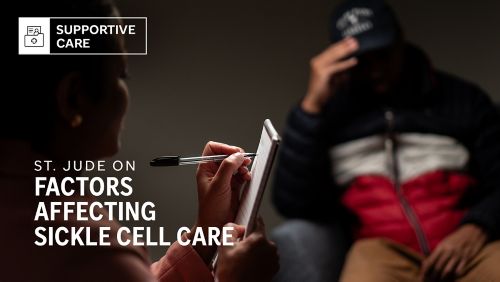St. Jude Family of Websites
Explore our cutting edge research, world-class patient care, career opportunities and more.
St. Jude Children's Research Hospital Home

- Fundraising
St. Jude Family of Websites
Explore our cutting edge research, world-class patient care, career opportunities and more.
St. Jude Children's Research Hospital Home

- Fundraising
Evaluating care for ‘the forgotten population’: Factors affecting sickle cell care

Jerlym Porter, PhD, interviews a patient to better understand their experience and barriers to care.
How do you measure your day? If you are like most people, you measure it in time. How do you use the hours available?
Perhaps you work, care for yourself or family members, tend to a to-do list, cook meals or enjoy a hobby. But what happens if you factor in the management of a chronic health condition for yourself or a loved one? Do you have time for appointments, treatments, transportation, rest and learning about the condition and the care needed?
Depending on the structure of our lives, finding the time and resources to devote to care can vary dramatically between individuals. As researchers now understand, the factors that influence the construct of our lives — the social and economic conditions that affect access to care — can drastically impact health outcomes.
Determining social determinants
Yvonne Carroll, RN, JD, Director of Patient Services for the St. Jude Department of Hematology, has met countless patients with sickle cell disease since 1999. But of all the patients she has encountered, Carroll still vividly remembers the woman who got up at 3 a.m. on her designated treatment days.
Waking at 3 a.m. ensured the patient could access the bus route that would drop her off at the hospital in time for her morning appointment, which usually concluded around 10 a.m. She would then spend the next seven hours at the hospital waiting for the evening bus route to take her back home.
In the seven hours someone else had the opportunity to complete their daily to-dos, she waited.
“A patient in that situation has to ask themselves what’s going to happen if they have an hourly job and have to miss a full day once a month,” says Carroll. It becomes a choice between two necessary means of survival: treatment or livelihood.
“That is a social determinant of health,” says Carroll.
According to the U.S. Office of Disease Prevention and Health Promotion, social determinants are “the conditions in the environments where people are born, live, learn, work, play, worship and age that affect a wide range of health, functioning and quality-of-life outcomes and risks.”
As part of Healthy People 2030, a U.S. initiative intended to advance disease-prevention approaches, social determinants are a priority consideration and constitute five key areas of focus: healthcare access and quality, education access and quality, social and community context, economic stability and neighborhood and built environment.
When applied to sickle cell disease, the consideration of social determinants offers an opportunity to expand what we consider disease variables to advance care for a chronic illness affecting millions worldwide.
Recharacterizing the roots of disease
While exact numbers are not known, the U.S. Centers for Disease Control and Prevention (CDC) estimate that sickle cell disease affects approximately 100,000 people in the U.S., most of whom are of African descent.
The chronic condition is caused by a genetic mutation that initially arose as a protective measure against severe forms of malaria in parts of the world where malaria is or was common, such as sub-Saharan Africa, South America, the Caribbean, Central America, Saudi Arabia, India and Mediterranean countries. Sickle cell disease is a chronic illness with genetic roots, not racial ones. But when genectic ancestry corresponds with skin color, that line is blurred.
“It’s often a forgotten population,” says Jerlym Porter, PhD, MPH, St. Jude Department of Psychology and Biobehavioral Sciences. “Because sickle cell disease is racialized, people use social determinants of health as evidence of ‘That’s just how it is; that’s just the environment they live in,’ which can lead to a defeatist perspective of ‘There’s nothing we can really do about it’ to better support our patients and families.”
For Porter and other St. Jude researchers and patient advocates, that kind of attitude serves as a call to action to address longstanding differences in how sickle cell disease is perceived, researched and treated.
Issuing a call to action for sickle cell disease
In a commentary published in The Lancet: Haematology, Porter and colleagues depict what the next frontier of research and care for those with sickle cell disease could look like if social determinants were considered a variable of disease.
Porter calls for research and care models to regard these determinants as aspects of disease that may be modifiable with a direct impact on outcomes and quality of life. Simply put, if the environment a person lives in and their access to care is considered just as vital as the medicine they receive, how might this change how disease is viewed and treated?
“It’s important to look at the whole person — and the field is moving toward that. It’s not just the biological, not just the disease process,” says Porter. “It’s everything that’s going on around them. The surrounding environment impacts a person’s experience of managing and living with a chronic illness.”
Porter stresses that understanding how social determinants influence people’s lived experiences with chronic illness is vital to shaping future research and care.
According to Porter, that information should come directly from the patients and families who live with sickle cell disease. “It’s important we keep the patient perspective at the forefront of our work. They are the experts,” she says.
Adopting this patient-centered approach, a team of multi-institutional researchers, under the leadership of Jane Hankins, MD, MS, Department of Global Pediatric Medicine, conducted a clinical trial to gauge whether using mobile health apps would increase patients’ adherence to their treatment regimen.
Porter, who developed focus groups and interviews with patients in the study, explains how the team listened and learned about patients’ specific barriers to accessing and taking hydroxyurea, one of the four medications approved for managing sickle cell disease. The team also collected patient input on what type of app features would improve and promote patients’ ability to access and take their medicine. The feedback was used to develop app functionality, and the results of the trial, published in Blood Advances, demonstrate a 19.8% improvement in medication adherence when the mobile health apps were accessed consistently compared to no app usage.
Listening and learning from the patient experience is central to developing and improving interventions that ease barriers created by social determinants.
Caring beyond the biological
“That’s the core of everything we are trying to do. How can we work with these families to get them the care they need,” says Andrew Heitzer, PhD, Department of Psychology and Biobehavioral Sciences.
For managing sickle cell disease, care often extends beyond the clinical treatment of biological states.
To contribute to this effort, Heitzer conducts neurocognitive assessments in pediatric patients with sickle cell disease to evaluate cognitive functioning from school age (ages 8 to 9) to early adolescence (ages 12 to 13) to late adolescence (ages 16 to 17) through the St. Jude Sickle Cell Assessment of Neurocognitive Skills (SCANS) program.
Heitzer says impacts on neurocognitive functioning are not just a byproduct of the disease itself. Social determinants, such as neighborhood (the places people frequent), or parents’ and caregivers’ education level and access to care, he explains, have the greatest impact on a child’s cognitive outcomes, and even more so for a child with a chronic illness such as sickle cell disease.
“All kinds of social determinants impact cognitive functioning. But it’s not just cognitive outcomes; it’s overall health and psychosocial well-being; it’s everything,” he says.
In research recently published in Pediatric Blood Cancer, Heitzer examines social determinants to determine the impact on neurocognitive and academic performance in pediatric patients (ages 4 to 18) enrolled in the St. Jude Sickle Cell Clinical Research and Intervention Program (SCCRIP). The team of researchers studied associations between household and neighborhood socioeconomic status (SES) factors, such as parental education and resources available in the community, with cognitive and academic performance. The findings demonstrated that poor outcomes were associated with both household and neighborhood SES.
Heitzer emphasizes behavioral interventions that aim to improve neurocognitive or academic performance for children with sickle cell disease need to account for social determinants.
Social determinants of health — just common sense
Establishing priorities for the research and care of a chronic illness that has been historically underfunded can be difficult.
Carroll explains that the funding has not been sufficient, even for basic scientific research on sickle cell disease. The way institutions allocate money for biomedical research can create an unintentional system of bias — affecting access and quality of care.
Since 1962, the research and care of sickle cell disease has been a priority for St. Jude: the hospital’s first research grant was to study the chronic illness. St. Jude is one of the only institutions equipped to provide care for children with sickle cell disease in the Memphis region. About 900 children (ages 0 to 18) from West Tennessee, North Mississippi and East Arkansas currently receive care for sickle cell disease at St. Jude.
Now, St. Jude researchers and clinicians continue to build on six decades of expertise as they explore under-investigated determinants of health that allow the field to assess sickle cell disease comprehensively.
“Considering social determinants of health is just common sense,” Carroll says. “If we can modify those, then we modify disease.”






